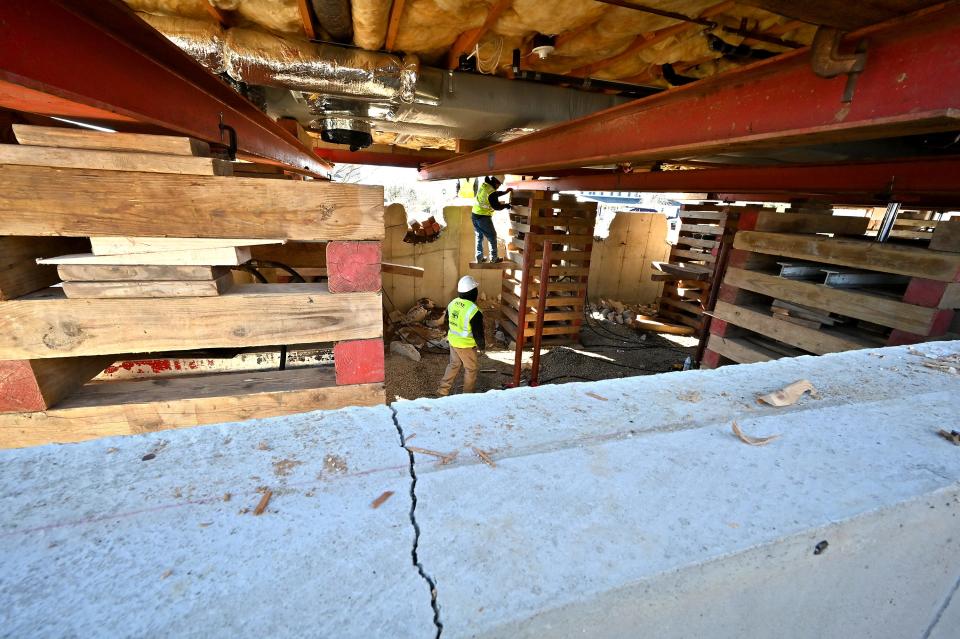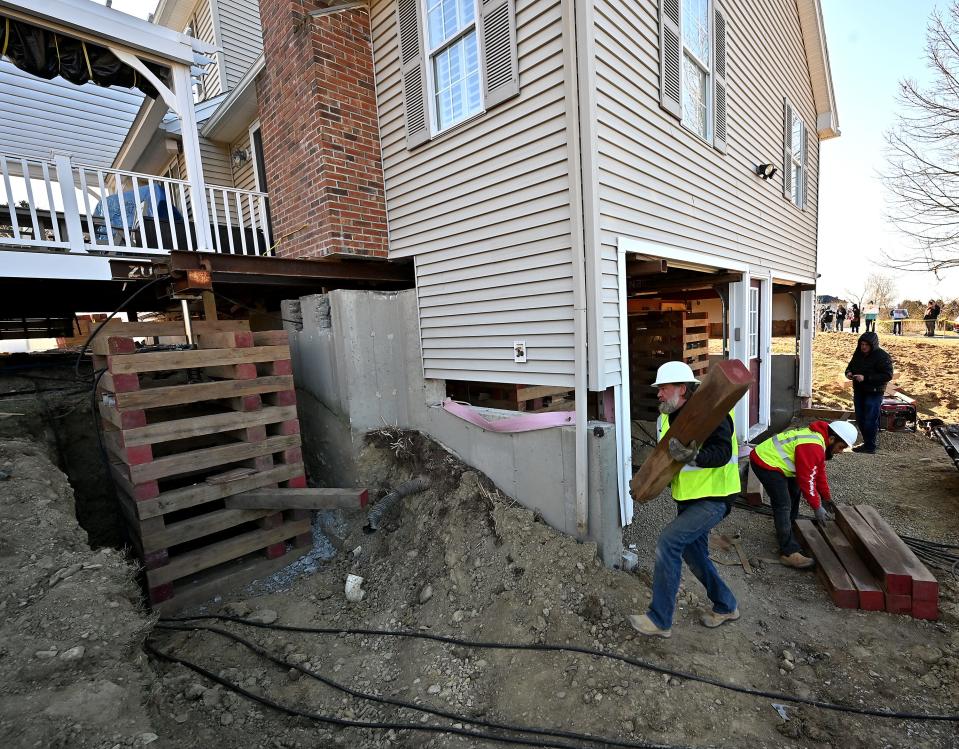Rutland house lifted to replace crumbling foundation laced with pyrrhotite
RUTLAND — When Kim and Jeffrey Haynes bought their house off William Circle in 2014, it felt like a good purchase.

Estimated to be around 2,500 square feet, the house was in proximity to the Wachusett Public Schools, where their daughter now attends high school.
But it wasn’t until spring of last year when the Hayneses started noticing cracks in the unfinished part of their house — the basement — that things started to change.
Tests showed that their house foundations contained pyrrhotite, a mineral found in the cement mixture that when exposed to water and air expands, forms cracks and turns concrete into powder, possibly causing a structure to collapse.
“Once we learned that our concrete was turning into powder, the only thing they can do is rip the entire foundation out,” said Kim, 52. “There's no fixing that. It just has to be replaced.”
The replacement process, which can take months, is done by lifting the house from its foundations to remove and replace the existing concrete.

For the Hayneses, that project was on its second day on Friday morning and required of them to temporarily move.
The couple and their teen will rent a residence in Worcester for the next three months, while having to adjust their work and their daughter’s education.
In total, Kim, a chemist, said the work is set to cost about $250,000, which not only includes the work and materials but also the testing of each load of new cement for traces of pyrrhotite so this problem does not happen again.
“Homeowners insurance does not cover this and there’s no state program,” said Kim. “We had to borrow against our retirement to do this.
“We're one of maybe few who could actually do this as we have the funds to do it. I think there are a lot of other families that don't, and they may know they have this issue and there's nothing they can do about it.”

Pyrrhotite is considered a statewide issue as it had tainted aggregate in about 1,500 to 2,000 Massachusetts homes, all built between 1983 and 2015 in certain areas of the state.
The mineral is found to be most prevalent in the Acadian metamorphic belt in the geological formation known as the Brimfield Schist, a geological formation runs through Connecticut, Massachusetts and into Canada.
Pyrrhotite has been described as an innocuous mineral that presents no danger to human health.
However, removing it could cost even as high as $450,000, according to experts, and with the damage and loss of equity, refinancing a home to remediate it can become next to impossible.
For Karen and Michael Cove, a retired couple who have lived only a five-minute car ride away from the Hayneses since 1994, when their house was built, said they are in the process of thinking about funding a house lifting and foundation replacement.
On average, the Coves are being quoted by different companies in the ballpark of $150,000, which is more than the $140,000 it took them to build their home in 1994.

“You get sick to your stomach,” said Michael, “and it’s always there."
“I'm always checking the walls,” added Karen. “It’s an emotional rollercoaster.”
The Coves said that another solution, although not ideal, is to support the foundations with fiberglass, but even the cost of that alternative is comparable to replacing the foundations.

To mitigate cost in the future, the state supports homeowners by reimbursing up to 75% of the testing, while starting July 31, all concrete-making companies have to test for pyrrhotite.
Sen. Ryan C. Fattman of the Worcester and Hampshire District attended the Hayneses’ house lifting on Friday, emphasizing the need for more financial help, possibly through a trust fund and by tacking a monthly payment of $1 onto every homeowner insurance policy.
In Connecticut, where the problem first came to light about 20 years ago, a reimbursement fund grants affected homeowners $190,000 toward foundation replacement costs through a bonding initiative. Similarly to what Fattman proposes, homeowners pay an additional $12 a year in their insurance policy.
Fattman also sees room for homeowners with pyrrhotite in their foundations in the Healey-Driscoll $4 billion package announced last October called the Affordable Homes Act, a bond bill defined as a package of spending, policy and programmatic actions.
“The vessel to fix this problem is coming,” said Fattman. “In that (housing bond bill) we could create a trust fund of $20 million to start, so that we can start addressing and reimbursing people who have already replaced their foundations or are in a desperate need to do it.”
Other state government officials, such as Sen. Peter Durant and Rep. Meghan Kilcoyne, also showed their support for the Hayneses on Friday, hearing from the couple about the issue.
"What worries me is that this is a ticking time bomb for so many homeowners that just aren't aware of it," said Durant later. "A lot of homeowners who don't know about it may say, 'It's not my fault and it's not my problem.
"It may not be your fault, but it may be your problem."
On Friday, Rick Riani, 65, stood outside the Hayneses’ residence to show his support as part of Massachusetts Residents Against Crumbling Foundations, a group of homeowners who discovered the same issue in their foundations and are now pushing state legislators to fix the problem.
Also dating to 2002, Riani’s Holden house also posed a need for its foundations to be replaced after Riani and his wife discovered cracks in their foundations due to pyrrhotite in 2021.
The project cost Riani and his wife about $280,000, forcing them to take out a home equity loan and 401(k)s to pay for the repairs.
About two years after the repairs, Riani said things are still not the same.
“We still have settling of the soil and we're still trying to put things back together,” said Riani. “It's almost back to normal but we just have this enormous mortgage now, which at the age 65 years old is just crazy.”
This article originally appeared on Telegram & Gazette: Rutland house lifted to replace foundation laced with pyrrhotite

